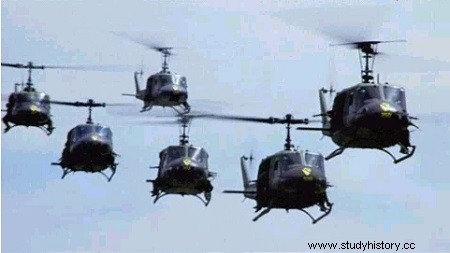
On the morning of November 14, Moore and his principal officers made a seemingly innocuous reconnaissance flight. In reality, they checked three possible landing zones and chose the largest, on which could land 8 to 10 aircraft at a time. From above, the terrain looked moderately open and was covered in tall, brown Napier grass under 30m tall trees. The ground was undulating and dotted with anthills about 2.50 m high. The trees grew denser towards the Chu Pong, and a dry riverbed skirted the face of what was to become the X—RAY landing area.
Moore returned to his base camp and sent a light observation helicopter to examine the area once more. When the helicopter realized that it had sighted telephone wires in the vicinity of XRAY, Moore took off his Bn. At 10:17 a.m., two batteries of 105 mm howitzers, from the er Bon. of the 21st of Aie., stationed about 9 km east of X-RAY launched a preparatory fire of 20 minutes on X-RAY as well as on the two other zones as a measure of deception. The rocket launchers of the 2nd Bn. of the 20th of Aie. took off and, the second the last projectile of 105 exploded, they presented themselves on X-RAY and unloaded there in 30 seconds half of their equipment. They then climbed and remained close by, ready to intervene on demand, while the Cie. A of the 229th Bn. aviation, combed the area before the landing of Moore and his Co. B. At 10.48 a.m., the aircraft returned for the Co. A while Moore's "operations" officer, his artillery liaison officer and his Air Force forward air controller flew over the area to, if necessary, direct artillery fire there, control the intervention fighter-bombers or relay messages by radio.
Once ashore, the commander of Cie. B sent small detachments to reconnoiter the edge of the woods, while the bulk of Co. remained waiting in thickets. At 11:20 a.m. an enemy deserter was brought back who told Colonel Moore that Co. American was in front of at least three Bns. Vietnamese who were eager to come to blows with the Americans. In fact. Chu had begun his movement towards Plei Me when he learned of the landings. He consequently had the 33rd and 66th Regts take up positions. west of the Chu Pong, along its base, by a maneuver which was accomplished noiselessly in less than an hour. The Co. B, who had found the deserter, continued his search to the northwest, along a ridge descending from the mountain, with two Sns. forward and the Sn. reserve according to Sn. left front. As it left the rump to cross the bed of a dry stream, it got a little ahead of the Sn. from the right and suddenly fell under fierce and precise infantry fire from an enemy unit hidden in the grass and whose strength was estimated at one Sn. The two flanks of the Sn. American were on display. The commander of Co. reacts by advancing the reserve and ordering the Sn. right front to move up to the right flank of the unit in difficulty.
As soon as the Sn. before the right had received this order by radio, it formed a line of skirmishers flanked by an M-60 machine gun at each end and advanced in the direction of the enemy. Along the way, his reserve platoon which followed, saw about twenty North Vietnamese disappear behind anthills on his left flank, between his position and that where he thought the Sn. from the left. Immediately the grenadier of the reserve platoon, using his M-79 grenade launcher, successfully launched grenade after grenade into the anthills, but he was shot down by a burst from his right. This burst was at the origin of a massive shooting, and it was the turn of the Sn. right to find themselves in difficulty. The leader of Sn. sent its machine guns to cover the platoon and formed a tight perimeter which. was
under fire from enemy mortars and rockets. Shortly after, the reserve platoon and one of the two machine-gun teams joined the position, bringing in the grenade launcher of the downed grenadier. The four men of the other team were unable to do so, and soon the enemy turned the captured machine gun against the Americans.
The commander of the company. B was certain that his Sn. on the left, the initial object of this rescue attempt, would have to transform herself into a rescuer, when he was joined by his Sn. Reserve. Meanwhile, Colonel Moore had established his command post in the landing zone and was busy transporting the Company. A to the left to protect the Company's flank. B, because he presumed that both Sns. on the left of the latter would be exposed when they made a conversion to help the Sn. isolated. It was around 1:30 p.m. and the first men of Co. They were being disembarked. Moore sent them to cover the Co. A by making them take position on the southern and southwestern edge of the landing zone. Moore's position was undefended to the rear, and the landing area was under mortar fire, but there was little more he could do. Nor the rest of the company. C nor the Co. D had not yet landed.
